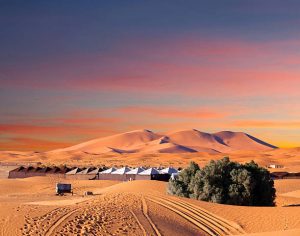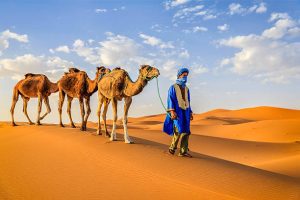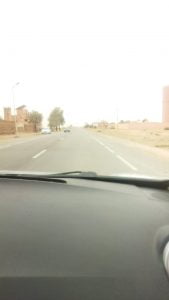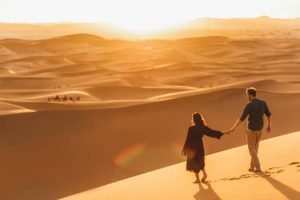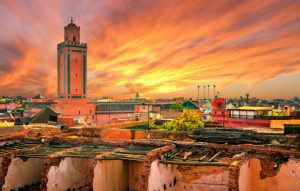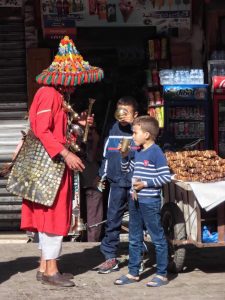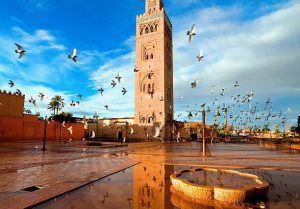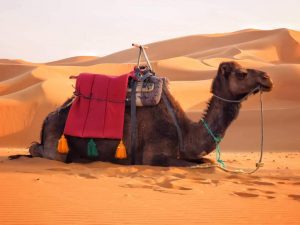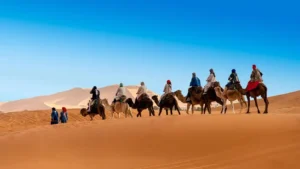Marrakech 8 days tour to Fes
Best of Marrakech Trip takes 8 days and includes a stop at Merzouga, in the heart of the Sahara Desert, before arriving in Fes. You can see the royal cities of Morocco, go camel trekking, go camping, and much more by booking a trip.
About This Tour
- Destination : Fes
- Start From : Marrakech
- Return Location : Marrakech
- Departure Time : 8 AM
- Duration : 8 Days / 7 Night
Trip from Marrakech to Fes in 8 days includes and excludes the following activities:
Include :
- Pickup & dropoff service.
- English/Spanish speaking driver.
- Accommodation.
- 4 WD vehicle with fuel.
- Breakfast.
- Dinner.
- Camel for each in the desert.
Exclude :
- Plane ticket.
- Travel insurance.
- Monuments fees.
- Lunches.
- Tips.
- Drinks.
On a 8 days excursion, these are the top points of the itinerary:
- Marrakech, the red city
- Cooperative of argan oil.
- Jamaa El Fna
- High atlas mountains.
- Ouarzazate Atlas studio.
- Todra Gorges
- Erg Chebbi sand dunes
- Camel trekking and Camping
- Meknes and volubilis
- Fes, the cultural city
8 Days trip from Marrakech to Fes itinerary's overview :
The High Atlas Mountains may be seen during the 8-day trip from Marrakesh to Fes through Merzouga (Erg Chebbi). Check out Telouat Kasbah and Ait Ben Haddou. Photos around “Atlas studio,” Roses Valley, and the Dades Gorges may be taken in Ouarzazate. Desert camping and camel ride in the Sahara.
Camping out in Berber tents deep in the dunes for the night before taking a different path back to Fes in the morning. The towns of Erfoud, Errachidia, Midelt, and Azrou will be visited, as well as the traditional market in Rissani. To go to Marrakech, we’ll first stop at Meknes, then Volubilis, then Chefchaouen, then Rabat, and finally Casablanca.
The schedule for a 8 days excursion from Marrakech to Fes :
Moving From Marrakech to Dades on Day 1
Dades Valley is the first stop on an 8-day trip from Marrakech to Fes via Merzouga. The trip begins with a morning pickup from your accommodation or the airport. We’ll be traveling via the High Atlas Mountains, round the 2260-meter-high Tizi N’Tichka pass.
We want to make a detour to the UNESCO World Heritage Site of Ait Benhaddou Kasbah. Some of the movies that included it were Lawrence of Arabia, Gladiator, and Kingdom of Heaven.
Take in the stunning countryside, complete with a rainbow of colors and quaint Berber outposts. We’ll take a break at a few different vantage points to snap pictures and enjoy the scenery. Visit Ouarzazate, often known as the “portal to the desert.”
Travel to Dades Gorges along the wonderful road of a thousand Kasbahs, stopping in Boumalne Dades for dinner and an overnight stay in a traditional Riad or hotel after seeing Kasbah Taourirt and the Films Studios.
Dades to Merzouga on Day 2:
After a traditional Moroccan breakfast, we’ll leave Dades for the Todra Gorges. Stroll through the narrow Dades gorges and take pictures of the 300-meter-high canyon walls, a favorite spot for mountaineers, before taking the Route of a Thousand Kasbahs to the town of Tinghir and the Todra Gorge.
The trip then proceeds to the Saharan town of Merzouga, where you’ll have time for lunch at a local eatery before reaching the Erg Chebbi dunes late in the afternoon.
Riding a camel for around an hour and a half will get you to the middle of the desert, where you can take in the stunning sunset from atop the highest sand dunes.
Spend the night in a Standard or Luxury Desert Camp under a sky bursting with brilliant stars while enjoying a delicious supper accompanied by live Berber drum music and dancing.
The Merzouga Desert on Day Three:
Before seeing the most magnificent dawn of your life, your camel guide will wake you up early to take in the scene. We’ll ride camels back to your Riad or hotel in Merzouga for breakfast, and then our off-road adventure over the sand dunes can begin.
Use this time to your advantage and educate yourself about Merzouga. Start your tour of Berber settlements with the Black People town of Khamlia. You’ll be given a cup of tea and treated to some evocative Gnawa music as soon as you walk through the door.
Learn about the nomadic lifestyle of living in tents and tending to herds of goats and camels while taking in a breathtaking panorama of sand dunes.
Stop by some deserted mines and a palm-studded oasis. Bring it back to Merzouga. You have some free time to explore Merzouga’s streets.
Day 4: Merzouga to Midelt:
We are leaving the Sahara Desert today after a spectacular off-road excursion and remarkable nomad encounters.
After breakfast, we’ll continue our 8-day journey from Marrakech to Midelt through Rissani and Erfoud, where you can experience authentic Souk shopping like a local. We continue on our trip to Midelt, stopping along the route to take in the panoramic panoramas of palm palms over the Ziz valley.
Following Errachidia, we’ll go via the volcanic Rich Ziz Gorges. The next step was to go to Midelt through the Tizi n’Talghamt pass. When you get to Midelt, check into a hotel for the night. Breakfast and supper will be provided.
Fifth Day: Midelt to Fes
After breakfast at your hotel, we’ll depart Midlet and continue on to Fes, the last stop on our 8-day trip from Marrakech to Fes via Merzouga. In the Middle Atlas Mountains, we will go through a region dotted with historic mud Berber villages.
Before reaching the little town of Azrou, we make a pit stop in the area’s famed Cedar forest to see if we can see any Barbarian apes (monkeys). Next, stop at Ifrane, Morocco’s “Switzerland,” on the way to Fes. Deliver to your Fes lodgings (hotel or riad).
6th Day in Fes, Sightseeing
During your time in Morocco, you can’t miss the exciting opportunity to explore the oldest beautiful architecture in Fes. Take a local guide on a half-day walking tour of the medina, and then spend the rest of the day at your own. The Fes medina has been a UNESCO World Heritage Site since 1981 and is the largest intact ancient medina in the world.
You’ll get a bird’s-eye view of the Jewish Quarter, the famous leather tannery in Fes, and the Nejjarin Museum in the Old Medina (Fes-el-Bali), which is Morocco’s oldest university. Don’t rough it; get a room at a hotel or riad.
Day 7: Fes to Rabat via Meknes and volubilis:
In the morning, depart for Rabat via the Meknes-Fes highway. Our first stop will be in the ancient city of Volubilis, where we may get insight into the daily lives of Moroccans in the time of the Roman Empire. This ancient Roman city was added to UNESCO’s list of World Heritage Sites in 1997.
When in Meknes, you must see the Bab El Mansour, the most famous gate in all of Africa, the Lahdim square with its spices Souk (market), and the Mausoleum of Moulay Ismail, the only mosque in Morocco that previously welcomed non-Muslims.
Then we will continue our trip to Rabat, Morocco’s political capital and also a coastal city, where we will admire the crenelated red ocher walls, visit the Kasbah of the Udayas, the iconic Hassan 2 tower, and the Mohamed 5 tomb. Stay at a hotel or riad in the Medina.
Moving from Rabat to Marrakech via Casablanca on Day 8:
Our 8-day journey from Marrakech to Fes, by way of Merzouga, came to a close today. Travel to Marrakech from Rabat via Casablanca in the morning. The day will start with a visit to the beautiful Hassan II Mosque in Casablanca after breakfast. The mosque is the second-largest in Africa and the seventh-largest in the world. The height of its minaret, at 689 feet, makes it the second-tallest in the world (210 meters). Before heading back to your original starting location of Marrakech.
The rest of the day is yours to do as you like after your arrival. Visit the famous Djemaa el Fna square and spend time doing whatever else was on your Marrakech itinerary before you left for Morocco.
We will then transport you to your hotel, riad, or airport, as appropriate. Our 8-day journey through Marrakech, Merzouga, and the imperial towns has come to a close.
Reviews for a 8 days trip from Marrakech to Fes :
The most amazing 8-day trip out of Marrakesh
We had a great time on the tour, and it was the highlight of our vacation to Morocco. We stopped many times to take in the breathtaking views. The hotel where we slept the first night, the restaurants where we ate lunch, and the desert camp, which is extremely comfortable, were all excellent. Hamid, our tour guide, is not only kind and enthusiastic but also fluent in English, and the automobile is first-rate. To see the sunset while riding a camel across Morocco is an unforgettable experience and should be on everyone’s to-do list.
Marla D
December 2019
Exceptional journey
Our journey across Morocco started last week! Without a doubt, our time in the desert was the most memorable part of the trip, but we were pleasantly surprised to find that our driver was a really wonderful individual. Moha was really helpful and kind from the moment we walked through the door. Our ability to form such strong ties in such a short time is really remarkable. Definitely out of the ordinary!
Caitriona C
jun 2019
Morocco's best family excursion.
We did an 8-day/8-night journey from Marrakech to Merzouga and back. First, we went from Marrakech to Dades to explore Moroccan wildlife. They said we could quad bike in the desert on the third day. Before we checked in, he escorted us there. Fun! After seeing Merzouga the next day, we rode camels to the desert camp. It was great to see the sun set and see the stars.
Tours are separated by hotel and food quality. This time, we chose a mid-range tour and were pleased with pricing and quality. They were hilarious. The tour’s driver, Hamid, was courteous and helpful. He brought us water and coffee and paid the tip so we didn’t need much money. He’ll drive you to the motel. The tour went without a hitch. Return! This time, longer desert camp!
michel S
December 2020
Have a question about the itinerary for the 8-day excursion from Marrakech to Fes ?
Please feel free to contact us if you have any concerns about the 8 Days travel from Marrakech to Fes itinerary. Any inquiries you may have will be answered with pleasure by our staff.
Brief Descriptions of the Locations:
Marrakech:
Our 8-day trip from Marrakech to Fes via the Merzouga Desert will allow you to see the highlights of Morocco’s most visited city, which draws some 3 million tourists annually. Abu Bakr ibn Umar founded “the Almoravid dynasty” in the 11th century.
The Berber word Amur N kush is the source of Marrakech’s name. Put another way, this is God’s domain. There are many other names for Marrakech. Some people call it the “red city” because the soil is so brightly colored that many residents choose to paint their houses the same shade.
To name just a few of the many attractions and activities available in Marrakech:
1. Jemaa El Fnaa:
It’s likely that Jemaa El Fna, the city’s massive central square, is the first thing that comes to mind when you think of Marrakech. It is not uncommon to interact with people from all over the world, in addition to locals. They come to watch the locals interact with the monkeys, snakes, and other wildlife. To be more specific, some people use the term “snake charmers” to describe them. In addition, it is common practice to sit in a circle, tell jokes and anecdotes, and generally have a good time. Some people are able to make a living off of this, and it has done so for millions of years. In addition, some people partake in deceptive games such as gambling and other forms of entertainment.
2. Koutoubia Mosque:
Jemaa El Fan Square is close to the Koutoubia Mosque. Actually, it is facing it. Consequently, after you’re done exploring the square, why not go there on foot? Be especially wary of motorcyclists, since they often disobey traffic signals and may attempt to steal your belongings, including your phone. The Koutoubia Mosque is also known as the Kutubiyya Mosque or the Booksellers Mosque, both of which refer to the front courtyard where books were formerly sold. This mosque is one of the Hassan Tower’s and the Grand Mosque’s sister mosques in Seville, Spain. Not to mention that the mosque is 70 meters tall with an 8-meter spire.
3. Majorelle Garden:
You should not visit Marrakech without paying a visit to the garden of French artist Jhon Jack Majorelle. It took the artist over 40 years to finish after it was first erected in 1923. After he died, the garden was taken over by Yves Saint-Laurent and Pierre Berge, who created a museum around it. They also set the price of admission at 70DH. But with the right ID, you may save money.
4. Menara Garden:
The garden of Menara, situated southwest of Marrakech, is where the bulk of the people go to enjoy the beauty of the lake in front of the lighthouse chamber.
An Overview of Ait Benhaddou
There are several Kasbahs in Morocco, and on our 8-day trip from Marrakech to Fes via Merzouga, you will get the opportunity to see a few of them. However, the Ait Benhaddou Kasbah receives the greatest praise and guests. During the time of the Almoravid dynasty, it was created by the Glaoui family in the 11th century.
The word kasab, which means “bamboo” in both Berber and Arabic, is where the word “kasbah” comes from. The word “Kasar” is spelled out in Arabic on a banner hanging over the Kasbah’s main gate. Nonetheless, this is false since Ksars, or palaces, are not the same as Kasbahs and their roofs are not built of bamboo.
Kasbah is a walled hamlet popular among the Berber Touaregs. The people who used to trade from South Africa to Europe all the way around the world. Slat mascara cole and other goods were formerly traded at the Kasbah. Approximately ninety families formerly called the Kasbah home. Recently, the population of the Kasbah has dwindled to a just five families, with most of the remaining residents being street vendors. The Kasbah has been on UNESCO’s list of World Heritage Sites since 1987. Beyond the walls are a mosque, two cemeteries (one Muslim and one Jewish), and a garbage dump.
Guests may have a taste of Touareg culture in a café created by one of the Kasbah’s families. Therefore, we highly recommend that you visit immediately.
1. Filmed at the Kasbah:
The Kasbah’s fame stems in large part from the fact that it has served as a filming location for several popular shows. As a starting point, many Moroccans would immediately shout “Lawrence of Arabia” since the iconic 1962 film was shot entirely inside the Kasbah. Another film linked to the kasbah is the 2000 British-American movie The Gladiator. To see a short video of it on YouTube, click here. The area has served as the setting for the filming of many more popular movies. Some examples of such movies are Marco Polo (1982), The Jewel of the Nile (1985), and The Mummy (1999). Our 8-day trip of Morocco starting in Marrakech includes a visit to the kasbah because of this.
Ouarzazate:
Getting to the Sahara Desert begins at Ouarzazate. The name Ouarzazate comes from the Berber language and translates to “city without noise.” On the other side, urban areas are not associated with peace and quiet.
You can’t avoid passing through this city if you’re taking a car from Marrakech to the desert, or vice versa. Why not have a look around and find out what the best attractions are?
To begin, the atlas studios are a major tourist attraction. Located in the center of Ouarzazate, the Kasbah of Taourirt attracts many actors looking to rent equipment for movies shot in the nearby Kasbah of Ait Benhaddou. Studios like the Oscar studio often include many of photos and stories about the people who worked there and the films they made. Toys and vehicles built entirely out of wood were also employed throughout production.
Furthermore, the Kasbah of Taourirt in Ouarzazate is a labyrinth that was built by the Glaoui Thami during his rule in the 19th century. A ticket is required to enter Taourirt, making it maybe the second most impressive Kasbah after Ait Benhaddou. That’s because several well-known movies have used the village of Ait Benhaddou as a location.
The biggest solar power facility in Africa is located at Ouarzazate. As was said before, Ouarzazate serves as a major entry point to the Sahara. Therefore, the city experiences very high summer temperatures, and the nation has taken advantage of this by erecting a solar power plant in the area. That’s not to imply the country is dry, but the energy from the sun is clean and unfiltered.
Those that dwell in the Rose Valley:
Kalaat Mgouna, also known as the Rose Valley, is a beautiful city known for its abundance of rose-based beauty products. Due to the popularity of the city’s annual Rose Flower Festival, which features live music and a wide variety of vendors, it has gained worldwide attention.
Tours of Morocco will take you through this charming city, with a break at a rose cooperative for shopping and rest after the two hours of driving.
Valley of the Dades:
On our 8-day trip across Morocco, we’ll stop at the Dades Gorges. Therefore, we’ll take you to the gorges to see the magnificently sculpted mountains there. Our destination for the night is Dades, and on the way there we want to stop for some sightseeing and picture ops.
The second halt will be at the Tissdrine bends, which are about 8 kilometers farther down the same gorges. If you’re not too exhausted, we could walk, but if you do feel fatigued, we could always use the car. What’s most remarkable about these curves is that they’re really Cadillac advertisements. As can be seen in the following picture, these curves provide a significant driving danger and are difficult to avoid. Consequently, the Cadillac reached a new peak three times in 3 minutes and 19 seconds, which is a new record.
The Gorges of Toggha
Canyons may be found in abundance in Morocco, another country rich in geological diversity. About 20 kilometers outside of Tinghir’s downtown are where you’ll find the most impressive canyons: the Todgha gorges. Tourists flock to the area to see the river’s dramatic descent from the surrounding mountains. Meaning the “water” of nature, which may rise up and smash the rocks in its way.
These canyons stretch for a total of around 984 feet. Therefore, many individuals have an intense urge to climb, even when the conditions are dangerous. It’s a nice place to take a stroll, take some pictures, and maybe even have a picnic.
This is Merzouga in the Sahara:
Our 8-day journey from Marrakech to Fes culminates in the Sahara desert. Merzouga is a native Arabic family name; the original name is Marzoug. Specifically, it’s in the Daraa Tafilalt region in southeastern Morocco. In addition, the distance to the Algerian border is short (around 50 km).
The Erg Chebbi sand dunes of Morocco, which are among the biggest in the world, are located near the little town of Merzouga. Because of this, plenty of people visit the region to take part in all the fun stuff to do there.
1. Traveling by camel via Merzouga:
One of the best activities in Merzouga is taking a camel ride or going on a walk. Many tourists ride the dunes during the day and then spend the night in Berber tents to experience the desert at its most authentic. A picture is included.
2. Sleeping in Berber tents at a campsite:
The only thing more exciting than taking a camel ride through Merzouga is spending the night in a traditional Berber tent. Glamping amid the dunes is a popular choice for many tourists. Therefore, if you find yourself in Merzouga Sahara, don’t be afraid to spend the night; doing so will allow you to experience nomadic Berber culture.
3. A trip to Srij Lake:
During our 8-day vacation in Morocco, we plan to spend a whole day in Merzouga. So, we’ll get you to Srij Lake in no time. It’s where the camels spend the day herding, however most tourists hire them around sunrise and sunset for picture ops. Furthermore, flamingos are migratory birds that may be spotted on the lake.
4. A trip to Gnaoua, Khamlia:
The little city of Khamlia is one of the most intriguing and interesting locations to visit. Our tour of the Merzouga Desert will allow you to meet the people of Khamlia, who have black skin. They are originally from Mali and Gabon’s south, and they have a superb sense of playing drams and Krakebs “castanet.”
5. A visit to a nomadic family:
We will take you on an excursion to visit one of the Berber homes that live in tents during our Merzouga desert vacation. We’ll show you where they live, who they cook for, and how they transfer their herds from one region to another.
Ziz Valley and Errachidia dam :
Valleys for farming and dams for reviving water supplies abound in Morocco. On our eight-day trip, we plan to travel via the valley of Ziz, one of the world’s greatest producers of dates from palm trees. It spans Algeria for a total of 282 kilometers, making it the longest river in Morocco. However, the dates are around 50 kilometers (30 miles) distant. The flood originates in the High Atlas Mountains.
The Errachidia Dam, which is not far from the valley of Ziz, is the Sahara’s water source. Actually, it’s evidence that the real king was clever to create those dams, since earlier, people in the desert had to depend on wells for water. The dam, which honors the founder of the Alaouite dynasty, goes by the name of Hassan Addakhil.
Cedar Needle:
The cedar forest is an excellent place to have a picnic and hang out with the monkeys.
Our 8-day tour of Morocco includes a trip in this cedar woodland to see the monkeys who make their home there. Barbary Macaques, popularly known as Barbary Apes and Magots, are a species of Barbary Macaque.
Many different kinds of animals make their homes here. There are deer, wild pigs, wolves, and many other species. However, the monkey is the only animal we’ll see on our tour; they love to interact with humans and are always looking forward to being fed and watered.
Ifrane, the switzerland of Morocco:
Ifrane is the most orderly and European-looking city in all of Morocco. Ifrane derives from the Berber word ifri, which meaning “caves.” Unfortunately, there are no caves close to the city. It was created in the 16th century by Sidi Abd al-Salam. The modern city, on the other hand, was built in 1928, when the French occupied Morocco. During the winter, many people, especially locals, go to Ifrane to snowboard as the city’s height allows for lots of snowfall.
Al Akhawayn University, one of Morocco’s biggest and most expensive schools, is situated in Ifrane. King Hassan II also officially opened it. Nonetheless, King Dhahir built it. That is why it is known as Al Akhawayn, which translates to “two brothers.” It was also sponsored by the Saudi Arabian ruler, Fahd bin Abdulaziz Al Saud.
The Atlas Lion Statue will be the first place we see in Ifrane. A German prisoner who was held by the French in return for his carving of this piece was eventually freed.
Fes:
Fes is one of Morocco’s most popular tourist destinations, thanks of its various well-known cultural attractions. It was initially erected in 789 by the Idrisid Dynasty. It was also Morocco’s first capital city, before Marrakech, Meknes, and the modern Rabat. Fes is presently classed as one of the country’s fourth imperial cities. The bulk of Fes’s sights are in the city’s historic district, Fes El Bali.
1. At the King’s Residency:
When you book our 8-day Morocco travel from Marrakech to Fes, we’ll take you to one of the king’s 12 palaces, or Ksars. There are a several other names for the palace that circulate. One of them is Dar al-Makhzen. It was built in the 1960s and is a great spot for photos because to its seven golden gates and doors.
2. Borj Nord:
We’ll take you on a panoramic tour of the historic Medina from the fort of Borj Nord. It was established in 1582 by the Saadi dynasty and was based by Portuguese forts in the 16th century.
3. Poetry “Mosaic” cooperative:
Following our excursion to the Nord Borj, we will go to the Mosaic cooperative. Seeing how they make pottery will be interesting, and Fes is a great place to get some to bring back with you.
4. Bab Boujloud, the blue gate:
The ancient Medina of Fes, also known as Fes El Bali, is ringed by a wall and is split into 11 gates. Bab Boujloud, or the blue gate, is the principal entryway. Its name derives from Abu al Junud, which means “father of the army.” The gate itself was built back in 1913.
5. Attarine Madrasa:
The Attarine Madrassa was created by the Marinid ruler Uthman II Abu Said in 1323. Its design made it renowned, and it is one of the most notable architectural accomplishments of the Marinid era. Attarine is derived from the Arabic word Attr, which meaning “spice dealer.”
6. University of Al Qarawiyyin:
If you’re in Fes, be sure to pay a visit to Al Qarawiyyin University, also known as Al Karaouine. It is both a university and a mosque devoted to the study of the holy Quran. Al Qarawiyyin is also one of the world’s oldest universities, predating the Alma Mater Studiorum in Bologna, Italy. It was established as a mosque in 859 by a woman called Fatima El Fihri. Then it was developed into a university.
7. Tannery of Chouara:
The leather is made in Fes, and there are three principal tanneries. But the most popular and best is the Tannery of Chouara. It was erected in the 11th century, and it is here that they barefoot tread skins in the dyeing pit.
Rabat:
Rabat is Morocco’s capital and one of the country’s four imperial cities, along with Fes, Marrakech, and Meknes. The Almohad dynasty erected it in 1146. In addition, with a population of 580,000 in 2014, it is Morocco’s eighth largest city. Morocco is split into 12 regions, with Rabat being part of the Rabat-Sale-Kenitra area. There are various locations to see and experience while traveling.
To begin, the Hassan Tower Mosque is a renowned tourist destination. Yaqub al-Mansur, the third caliph of the Almohad, had it built in 1195. With 86 minarets, this guy hopes to make it the world’s biggest mosque. However, he died in 1199 before finishing it. Now just 44 meters in length instead of the original 100, this formerly grand structure has been designated a World Heritage Site by UNESCO.
Rabat’s Les Oudayas Kasbah, built in the 12th century, is Rabat’s second must-see site. The Arab Andalusians and some Arab tribes called it home. One of the World Heritage Sites recognized by UNESCO.
Casablanca:
Casablanca was developed in the 7th century as Morocco’s commercial and greatest city, with a total size of 220 km2. It also had a population of 3.36 million people in 2014. Most Moroccan cities, including Casablanca, were constructed in the Morish style when Morocco was under French rule.
Casablanca is famed for its Hassan II Mosque, which is the biggest mosque in Morocco, the second largest in Africa, and the seventh largest in the world. It has a 210-meter minaret, making it one of the tallest in the world (690 feet). Bouygues, a French business, constructed it in 1989. It was likewise designed by Michel Pinseau. Furthermore, most Moroccan mosques do not allow visitors to see their interiors. However, visitors to this mosque are encouraged to go inside and look around.
Our 8-day trip from Marrakech to Fes includes a visit to Casablanca.
Itineraries similar to the 8-days travel from Marrakech to Fes
Morocco offers a number of custom trips that may be taken from Marrakech, Fes, Casablanca, and Tangier, in addition to the popular 8-day desert tour from Marrakech to Fes through Merzouga. Pick one, or get in touch with us to arrange a trip that is tailored to your needs.


